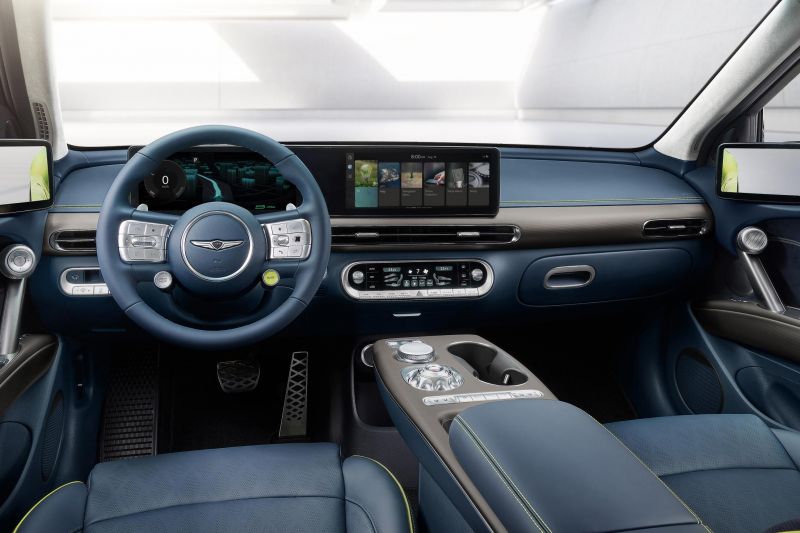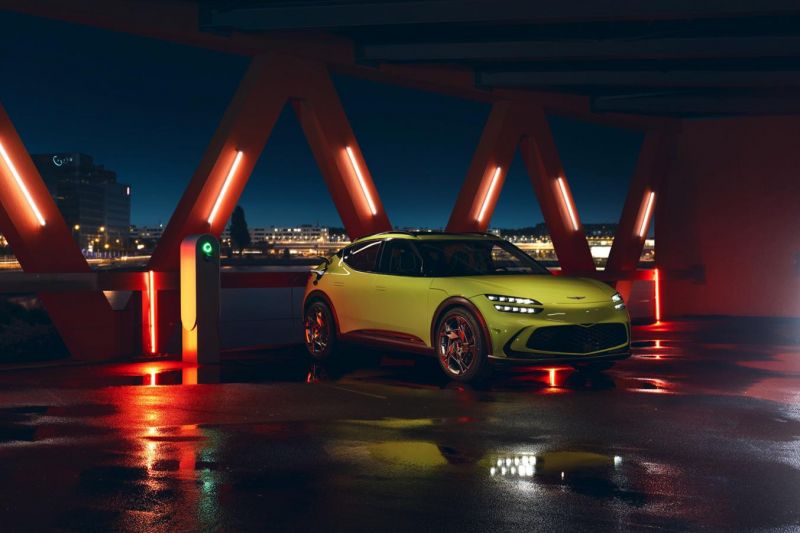Genesis is telling customers its first ground-up electric vehicle will cost a cool $25,000 more than than the closely-related Hyundai Ioniq 5.
A member of the Genesis Vehicles Australia group on Facebook says the company is contacting potential Australian customers with information about a two-model GV60 range, with pricing starting north of $100,000.
The base dual-motor all-wheel drive model will be priced between $100,000 and $110,000 excluding on-road costs but including Luxury Car Tax (LCT).
The flagship Performance, in contrast, will be priced between $110,000 and $120,000.
Genesis hasn’t officially confirmed pricing, but CarExpert understands the price ranges quoted to the customer are accurate.
No mention was made of a single-motor rear-wheel drive version, though one was certified for sale earlier this year.
Whether Genesis may choose to introduce it later as a price-leader model is unclear.
The GV60 is set to launch in the third quarter of this year, along with the Electrified GV70 SUV and Electrified G80 sedan that are based on combustion engine platforms. Pricing for these models has yet to be announced.
The $100,000+ pricing puts significant distance between the GV60 and the other vehicles underpinned by the Hyundai and Kia E-GMP platform.
The Hyundai Ioniq 5 tops out at $75,900 before on-roads in dual-motor all-wheel drive guise, while the flagship Kia EV6 GT-Line AWD is priced at $82,990 before on-roads.
Kia will introduce a more powerful EV6 GT late in 2022 or early in 2023, however, and dealers have been advising customers it’ll be priced around $100,000.
The petrol and diesel-powered GV70 range, which features a more traditional SUV-style body than the GV60, is priced $66,400 and $83,276 before on-roads. It’s 200mm longer than the GV60, though its wheelbase is 25mm shorter.
The GV60 is closer to the likes of the 4.46m-long Mercedes-Benz EQA in size rather than the 4.76m-long Mercedes-Benz EQC, though it has the packaging efficiencies that come with a dedicated EV platform.
It’s also smaller than another ground-up EV, the Tesla Model Y, which measures 4.75m long and is priced from $72,300 before on-road costs. In Performance guise, the Tesla costs $102,329 list including LCT.
Government certification documents earlier this year revealed the standard dual-motor GV60 will ride on 20-inch alloy wheels, while the flagship model will use 21s.
CarExpert understands features like camera mirrors and battery preconditioning could feature on the Australian-market GV60.
The preconditioning feature allows the car to adapt its battery temperature while travelling to ensure optimal charging conditions upon reaching a charging point entered into the navigation system.
Camera mirrors, as seen on the Audi e-tron, see the conventional exterior wing mirrors replaced with external cameras, from which footage is displayed on screens inside the cabin.
The GV60’s wireless vehicle charging feature, however, is understood to be off the table. Genesis is debuting the feature with the GV60, but it won’t be activated in markets until after the necessary infrastructure is established.
The standard all-wheel drive model combines a 160kW rear motor with a 74kW front motor for combined outputs of 234kW and 605Nm.
Finally, the range-topping performance model has two 160kW motors for a peak power output of 320kW, and an identical peak torque figure of 605Nm.
In its Boost Mode, which primes the motors to provide peak output for 10 seconds, the fastest GV60 hits 100km/h in 4.0 seconds from standstill.
That means even the flagship GV60 will be shaded by the upcoming EV6 GT, which will do the same sprint in 3.5 seconds and produce 430kW and 740Nm.
In its most aggressive mode, Genesis says the regenerative braking system allows for true one-pedal driving. Drivers will be able to toggle different regen levels using the paddles behind the steering wheel.
All models can tow 750kg (unbraked) or 1600kg (braked) according to the approval documents.
Every GV60 variant uses a 77.4kWh lithium-ion battery pack. Genesis claims 470km of range on the WLTP cycle for the standard all-wheel drive model and 465km for the Performance.
Thanks to the 800V charging hardware baked into e-GMP, the GV60 is capable of charging from 10 to 80 per cent in 18 minutes on a 350kW public DC fast charger.
It’ll charge at 11kW plugged into the right kind of AC wall box and, like the related Ioniq 5 and EV6, it can output 3.6kW of power to run appliances or charge (slowly) another electric car.
The GV60 uses the same active adaptive suspension system as the GV80 SUV. It uses a camera to scan the road and, combined with sat-nav data, adjust the damping on the fly.
Along with technology designed to mimic a limited-slip differential on the rear axle, the GV60 features a Drift Mode. It’s activated by putting the car in Sport, turning off the ESC, and holding the steering wheel paddles for three seconds.
It debuts a new face unlock feature for the brand, which will adjust the driver’s seat, steering wheel and side mirrors based on the driver’s customised settings.
Once you’re inside, a fingerprint sensor in the start button allows the GV60 to start without a key. It can also be used to authenticate payments for charging, and to lock the car into Valet Mode.
Other features available in Korea include an 18-way power driver’s ‘ergo motion’ seat with massaging, reversing guide lights, a 17-speaker Bang & Olufsen sound system, Genesis’ Intelligent Front Lighting System, and Highway Driving Assist 2 with lane-change assist.
Like its more affordable cousins, the GV60 is also offered with the Blind-Spot View Monitor, a surround-view camera, and Remote Smart Parking Assist.
It’s unclear if we’ll miss out on any features offered in the Korean-market model like the Ioniq 5 has.
The Ioniq 5 is offered in Korea with an augmented reality (AR) head-up display and a solar roof but neither feature is offered here, though the former can be found on the EV6 GT-Line.
The GV60, in Korea at least, is also offered with the AR head-up display.
















